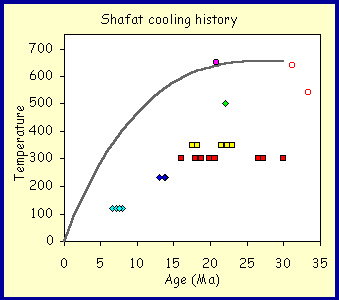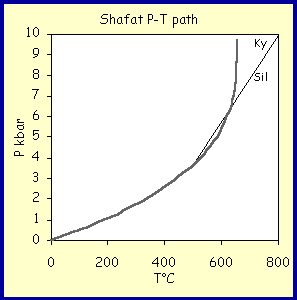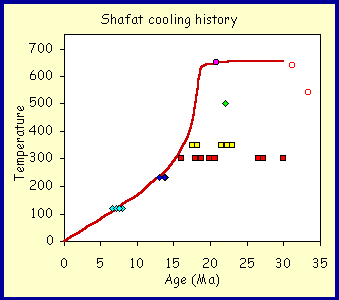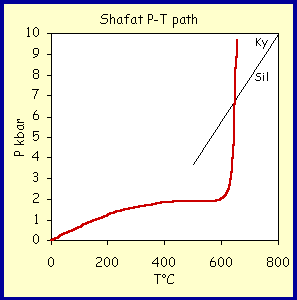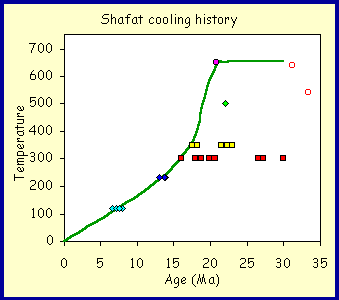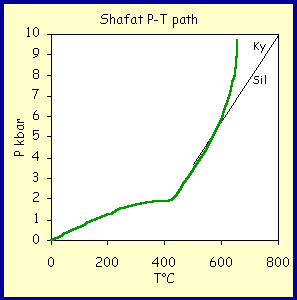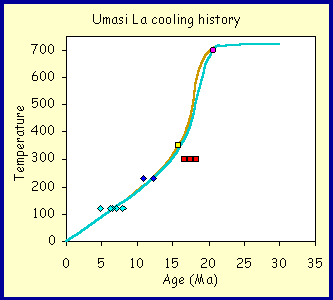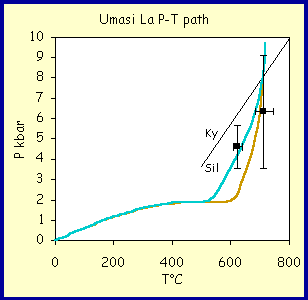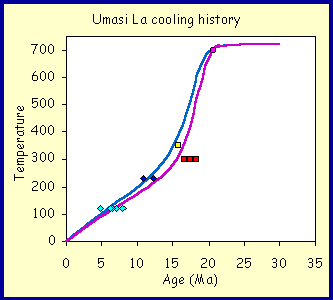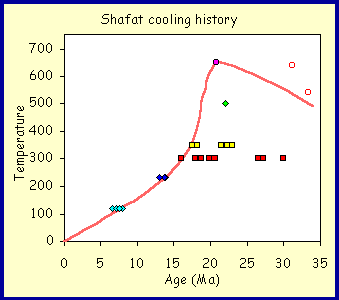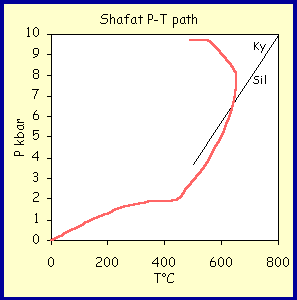P-T-time models for the exhumation of the Himalayan slab
These slides show the results of applying a simple conductive thermal model to constrain the timing and rates of exhumation in the Zanskar Himalaya. The aim is to fit both the temperature-time evolution from geochronological data and the P-T path revealed in mineral assemblages and textures.
- The temperature-time framework at Shafat
- Exhumation by erosion at uniform rate (Shafat)
- Three-stage exhumation, by erosion (Shafat)
- Three-stage exhumation, with an extensional detachment (Shafat)
- Three-stage exhumation of the Umasi La locality
- Cooling from below by movement on the Main Central thrust
- Full prograde and retrograde evolution (Shafat)
1. The temperature-time framework
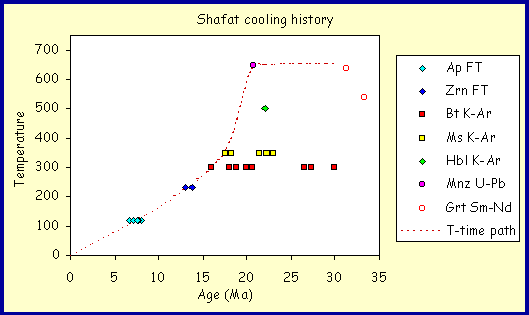
The geochronological constraints on the T-time path for rocks at Shafat in the Suru Valley traverse are shown here. Prograde garnet growth leads up to the metamorphic peak at about 30 Ma. Temperatures are inferred to have remained near the maximum until granite vein emplacement at 20.8 Ma (monazite U/Pb age), then fallen during rapid exhumation, reaching ca. 300°C by about 16 Ma (closure T for Ar in biotite). Thereafter slower steady cooling is recorded in fission track ages. Some of the argon ages are affected by excess Ar and spread to higher values.
2. Uniform uplift and erosion
The simplest possible model, with exhumation at a uniform rate by erosion, is totally at odds with the observed T-time path (left), although the P-T path (right) more-or-less satisfies the constraint that the first part of the cooling path should remain within the kyanite stability field. This is a situation originally modelled by England and Richardson (1977, J. Geol. Soc. Lond. 134) and is commonly assumed for simple modelling of older orogenic belts where the exhumation mechanism is not known. See how wrong it can be!
3. Three-stage uplift, by erosion
This shows a more appropriate three-stage exhumation history, with a period of rapid exhumation around 20 Ma sandwiched between periods of slower unroofing. Exhumation is purely by erosion. The form of the cooling curve is now correct, but these models cannot exactly fit the T-time curve if the conditions of granite emplacement at 20.8 Ma are required to be in the kyanite stability field, because the fall in temperature is delayed too long to match the muscovite cooling ages. The model P-T path is strongly convex to the T axis, and grossly discordant with observations which suggest that the path remained (just) in the kyanite field, at least for the first part of the cooling.
4. Three-stage exhumation, with an extensional detachment
In this three-stage model, the exhumation during stage 2 (21 to 18.5 Ma) is taken up on an extensional detachment (representing the Zanskar Shear Zone), located 4 km above the modelled locality. This model is one of several which give a good fit to both the T-time and P-T constraints. In the successful models, stage 2 involves the removal of 18 to 25 km of cover in 2.5 to 3 Ma, at exhumation rates of 6 to 10 mm/a. The model above has
| Stage | Duration | Exhumation mechanism and rate |
|---|---|---|
| 1 | 30 - 21 Ma | Erosion, at 0.68 mm/a |
| 2 | 21 - 18.5 Ma | Detachment 4 km above, at 9 mm/a |
| 3 | 18.5 - 0 Ma | Erosion, at 0.4 mm/a |
5. Three-stage exhumation of the Umasi La locality
The Umasi La locality records higher peak temperatures, and although the age of migmatisation and leucogranite emplacement is identical, the cooling ages are all 1 or 2 Ma younger. Nevertheless, the data can be fitted using the same exhumation parameters as at Shafat, provided the distance beneath the detachment is taken to be 6 km or less (blue curve). The observed distance, however, is more like 10 km. At this distance (brown curve), the temperature does not fall rapidly enough to satisfy the retrograde P-T conditions, and anyway this model implies that the detachment would be exposed at the surface before the end of stage 2 at 18.5 Ma. An additional cooling mechanism may be required (such as cooling from below, considered next).
6. Cooling from below by movement on the MCT
In practice, underthrusting of cold material on the Main Central thrust may also be expected to have an effect on rocks in the interior of the slab. The distance to the MCT beneath the Umasi La locality is not known, but is unlikely to be less than 15 km. These model runs show the effect of inserting slabs of cold material 15 km beneath the locality at the beginning of stage 2, simulating movement on the MCT at 21 Ma. The effect is similar to that of a detachment a long distance above - with this mechanism alone (blue curve) the rocks do not cool rapidly enough in stage 2 for the retrograde constraints to be satisfied. However, a combination of cooling from a detachment above and a thrust below (purple curve) can adequately reproduce the T-time and P-T history of the Umasi La locality if it is placed at 10 km beneath the Zanskar Shear Zone and 15 km above the MCT.
Models which cool the deeper parts of the section in this way also require a higher exhumation rate during stage 3 (in this case 0.54 mm/a) to match the low-temperature cooling history.
7. Full prograde and retrograde evolution at Shafat
It is also possible to make simplistic models which approximate the entire prograde and retrograde evolution, such as this one, in which crustal thickening by stacking thrusts occurs from the time of collision at 50 Ma. A purely conductive model with appropriate internal heat generation in the thickened pile is well out of thermal equilibrium at 30 Ma, and the temperature continues to increase at first during unroofing, until the onset of rapid stage 2 exhumation. It would require a more sophisticated model to fit the prograde garnet ages of Vance and Harris (1996), shown by circles. This model for the Shafat locality uses the same exhumation rates and timings as before, the similarity of the result confirming that the fitted exhumation parameters are not particularly sensitive to the starting conditions.
Created September 1997


